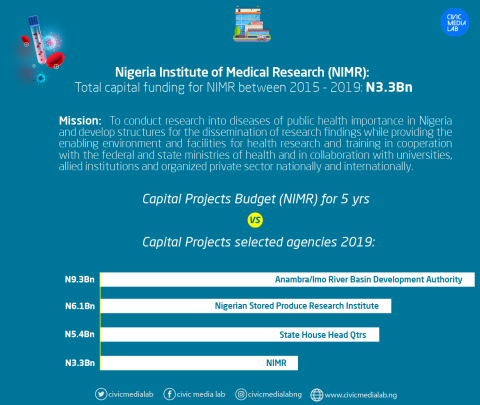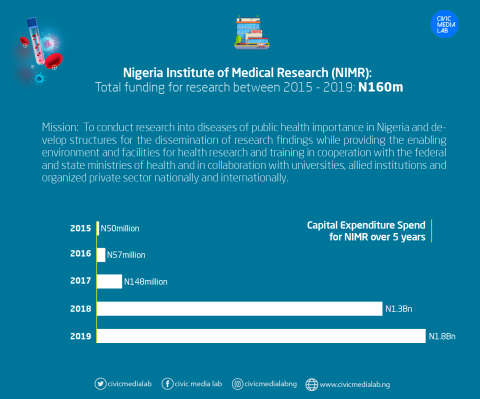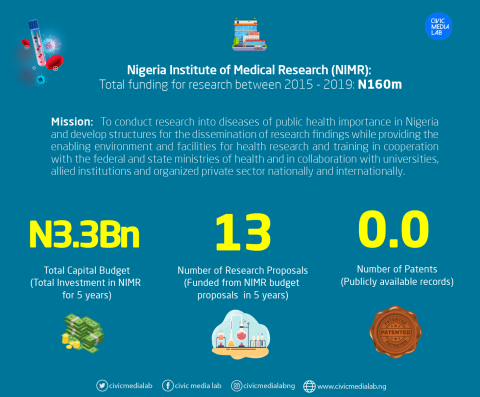In this six part series, we look at how these institutions have been funded in the last five years, while also assessing their outputs in the period under review. In this first part, we examined the Nigerian Institute of Medical Research.
As the COVID-19 pandemic continues to ravage countries in the world, several countries through government-funded institutions are working round the clock to contain the spread of the virus. The Civic Media Lab examines the efforts of government institutes and agencies in Nigeria that should be leading the country’s medical research into finding possible solutions to several outbreaks including the current COVID-19.
In this six part series, we look at how these institutions have been funded in the last five years, while also assessing their outputs in the period under review. In this first part, we examined the Nigerian Institute of Medical Research.
Low budget, frivolous projects, one output
In five budgeting cycles between 2015 and 2019, the Nigerian Institute of Medical Research, failed to conduct any Federal Government-funded research into the country’s management of the Ebola and Lassa fever outbreaks in the country. In 2014, Nigeria was able to contain the Ebola epidemic within two states but Lassa fever has remained a reoccurring theme with 987 confirmed cases and 188 deaths as at the week ending April 25, 2020, according to the Nigeria Centre for Disease Control.
Based on data obtained from the website of the Budget Office, Civic Media Lab observed that NIMR received an estimated envelope of N3.33bn for capital expenditure between 2015 and 2019.
The institute made no provision for research in 2015 but in the other four years, the CML found 13 research themes and three reoccurring ones. Two of these descriptions that reappeared, had a couple of different research subjects lumped into their description in the two budget cycles they occurred in.
Of all the research themes it listed, the lab found only one paper published on the institute’s website. Sources attributed the dearth in field research to a neglect of the agency, which began receiving improved funding for capital expenditure from 2017 onward. They say the infrastructure of the institute was in disrepair and needed up-scaling before monies could be diverted to studies.

What the 2015 budget revealed
The Federal Government’s posture at this time was solely to pay salaries. In 2015, the total recurrent expenditure – personnel plus overhead cost was N812.53m.
The only capital project provided for by the institute was the repair of staff quarters, admin building and laboratory complex valued at N50m.
What the 2016 budget revealed
In the first budgeting year of the President Muhammadu Buhari administration, the institute requested for N10.265m to be shared across eight researches. The most expensive study, “National Research on Common Causes of Sudden Death Among Adults in Nigeria” gulped N2.36m while the cheapest, “Research On Identification and Monitoring the Causative Agents of Cholera Meningitis Outbreaks in Six Geo-Political zones of Nigeria,” received N917,711.
The other six research undertakings the institute requested funding for were a study on new antimalarial drugs on children and pregnant women; another on the resistance of tuberculosis to available drugs; a national survey on the prevalence of human papiloma virus and cervical pre-cancer. Others include on the use of alcohol and its effect on unborn children by their mothers in Nigeria; collation and dissemination of research findings in scientific journals and the geographical pattern of child mortality.
Capital funding to the medical institute increased by N6m, from N50m in 2015 to N56.08m in 2016. Although personnel cost and overheads still dwarfed productive spending, total recurrent expenditure reduced to N759.84m. One source at the institute described the administration that ran the institute before the appointment of Babatunde Salako in 2016, as ‘awful,’ saying staff were not carried along and funding for research was almost non-existent.
What the 2017 budget revealed
In 2017, the trend of diminishing reoccurring spending and increased capital provisions continued. The total funds approved for recurrent expenditure dropped from an approximate of N759.84m in 2016 to N678.96m in 2017, while the total capital spending increased from N56.08m to N147.62m.
For its capital provision – N119m was designated for eight research topics. N100m of the entire package went into a study on ‘Poliomyelitis and Diarrhea Disease and Malnutrition.’ Its cheapest request was N1m for the “Collation and Dissemination of Research Findings through Publications in Local and International Collation, Research Journals and Purchase of UNESCO Coupons for Books for Library.” [story_link align="left"]80285[/story_link]
The institute also received approval to obtain funding for a national survey on the prevalence of HIV and cervical pre-cancer; the study on the prevalence of Cholera and Meningitis across the six geopolitical zones popped up again. There was also a human capital building programme for increasing its research and development capacity – it did not state whether it was for internal staff or external researchers on a particular project; the relationship between nutrition and oral polio as well as measles vaccines in children in the North and South of the country. Others include a vague sounding research – ‘the Utility of Electronic Reminders to Improve Antiretroviral Adherence in Adolescents Living with HIV’ and a site identification for Malaria Elimination and Vaccine Trial.”
The study of the prevalence of cervical pre-cancer, and the dissemination as well as collation of research for publication in local and international journals, were the two reoccurring projects lumped with different themes in 2016 and 2017. With the exception of “National Research on Common Causes of Sudden Death among Adults in Nigeria,” CML could not find any of the research topics the institute proposed to embark on both on its site and on Google.
What the 2018 budget revealed
Based on the findings made by CML, there were no research themes in 2018. Only one vaguely named line item – Research and Development, valued at N30.5m was budgeted for. This is separate from research-related procurements and constructions.
CML also discovered across the agency’s budgeting, a flare for lumping projects together. In one instance in 2018, the institute wrote: “Procurement and installation of special laboratory equipment: flow cytometer, mycobacterium cm/as kits andcentrifuge.” In another line item it said: “Procurement and installation of special laboratory equipment: workshop on private sector involvement in funding medical research in Nigeria.”
The institute also asked for N107m for the “procurement and furnishing of researcher's suite.” In another project description it asked for “Construction of researcher's suite” at the cost of N107.5m. It is unclear if it was asking for a different researcher’s suite, as the locations of the suites were not stated.
CML also found out another bogus line item which just reads: “construction of laboratories,” at the price of N65.38m. This is the year when funding for capital projects and recurrent expenditure traded places.
Reoccurring spending made a slight jump from an estimated N678.96m in 2017 to N685m, while capital spending skyrocketed from an approximated N147.62m to N1.30bn.

What the 2019 budget revealed
This year followed a similar pattern to the last. However, funding for the construction of ‘Researcher’s Suite’ was down to N42.62m, while funding for the ‘Procurement and Furnishing of ‘Researcher’s Suite,’ was down to N32m.
The purchase of UNESCO coupons, as well as the collation and dissemination of information through scientific journals increased to N6.40m. The institute did not list out its research themes but chose again to put-up ‘Research and Development’ at the value of N107.90m.
In an apparent sign of amnesia, the agency listed this project: “procurement and installation of special laboratory equipment: workshop on private sector involvement in funding medical research in Nigeria,” as a new project. Just like in 2018, ‘Research and Development’ was the only study targeted project in the institute’s budget. This year, the recurrent expenditure was N840.91m and capital funding was up to 1.83bn.
CML however, recognises that N100m was allotted to the Cancer Research Centre which the institute runs but the appropriation was not for any form of surveillance or study.
Also, the CML could not spot any update on the Malaria elimination and vaccine trial in the 2018 and 2019 budgets. The institute had requested for N4m for that particular project in 2017. “That theme would be in one of the things we are supposed to be doing but they don’t really have funding for it,” a source close to the institute said.

A government not focused on solution
Research is still not receiving attention from the Federal Government through NIMR.
“The truth of the matter is they are not funding research at the government level. In spite of the fact that I say we have had more money in the last two years, they are still not funding research,” the source said.
“With this COVID-19 scenario, no money has come to NIMR, the money that has come to NIMR has been from private individuals,” the source added.
Between December 2016 and June 2017, Nigeria played host to the largest global Meningitis outbreak. The virus is suspected to have started some two three months before late December when the Nigeria Centre for Disease Control was notified.
The country is largely dependent on WHO and other foreign partners for dealing with epidemic outbreaks, yet these groups were not informed until February 2017, meaning Type C vaccines were not brought in to stop the infection till April 2017.
By the time the flames were put out, 14,513 persons – most of whom were children had been infected while 1,161 had died – a fatality ratio of 8.0 per cent.
Despite this slip up in the health sector, the Nigeria Institute for Medical Research failed to make its findings on the outbreak known, although it budgeted N3.4m for it in two years.
More conspicuous though is the failure of the agency to look into the rise in positive Lassa fever cases in the country since 2015. In 2015, Nigeria recorded 64 confirmed cases of Lassa fever. This number rose to 152 in 2016, climbed to 246 in 2017, jumped to 431 in 2018, leaped to 810 in 2019 and has flown up to 987 as at the week ending April 25, 2020.
A consultant to NIMR, Dr Akintunde Akoni, said, “NIMR has decided to open its doors to relevant stakeholders particularly in the IT sector, such that CCHub is now a collaborator in research with NIMR.”
He added that researchers outside the institution and funding from the private sector were been attracted into the agency.
He is confident that the institution will be able to take on more research in years to come as its labs have been ‘scaled up’ to global standard.
An anonymous voice within the institute corroborated his views saying, ‘this administration has been more accountable,’ ‘quality of life has improved’ and ‘there is hope for the future.’
However, Civic Media Lab Director, Oluwaseun Akinfolarin, disagrees. He believes that private sector funding should not be the solution to the institute’s protracted inefficiency.
According to him, an institute like NIMR has been neglected over time and this is reflected in the current situation.
He said, "They should have enough funding to design and commission researches to problems that have been identified in the health sector without having to seek help from the private sector.
“Even before the Coronavirus outbreak, we have problems like Lassa fever in the country that reached an all-time high this year but nothing has been done about it."
He stated that the government had failed in this regard, noting that this failure was responsible for the slow progress the country is witnessing in its fight against the pandemic as it keeps waiting for foreign aid to save the day.